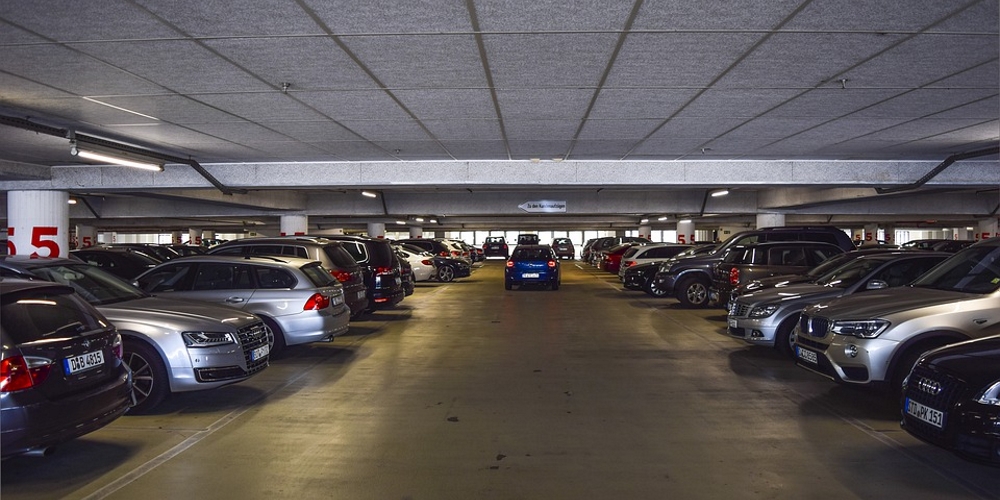
When you do your driving test, the examiner might ask you to reverse into a parking bay or to drive forwards into a bay and then reverse out.
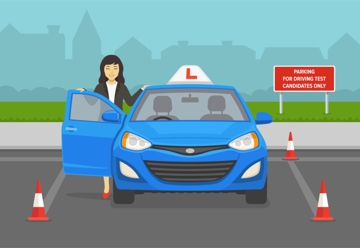 But there is a lot more to safe parking than simply being able to control your car during this driving test manoeuvre.
But there is a lot more to safe parking than simply being able to control your car during this driving test manoeuvre.
This manoeuvre is tested to ensure that:
After you have passed your driving test, there will be lots of occasions when you will be parking in car parks - you need to be able to park neatly and safely to avoid the risk of damage to your vehicle and to ensure your personal security.
In addition, and more importantly, you will have to ensure that you do not cause danger to other people in the car park.
Demonstrating your car park skills will show the examiner that you can control the car and keep it safe in other low speed situations, for example, manoeuvring near fuel pumps or chargers or reversing into garages.
You can see more roundabout videos in the Driving Test Success practical driving app. (Google Play | App Store - appstore practical videos available as an in app purchase in the 4 in 1 kit)
During your driving test, the examiner can ask you to reverse into a parking bay or to drive into a parking bay and then reverse out again.
You might be asked to complete the manoeuvres in the test centre car park or a car park somewhere along the test route. This means that even if your local test centre does not have a car park, the manoeuvre can still be included.
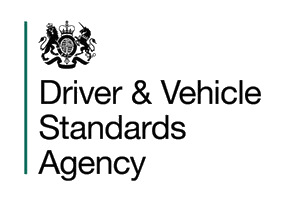
The examiner will want to see:
All-around observation as you park
Correct use of controls
Reasonable accuracy
The car parked neatly between the lines
Dealing with other car park users safely

These are some of the problems that can happen in car parks - following the advice in this lesson will help make sure that they don't become problems for you!
Accidents happen in car parks because drivers:
Reverse without looking properly
Drive around car parks in the wrong direction
Go too fast in confined spaces
Rush their parking manoeuvres because they are embarrassed about holding up other drivers
Drive into spaces where it would be appropriate to reverse in
Although you will drive slowly in car parks, they need as much concentration as busy roads. Other car park users might be in a hurry, trying to keep control of small children, chatting on the phone or unaware of what's happening around them.
Pedestrians are particularly vulnerable; even a low-speed bump can cause severe injuries, especially to children and older people. There have been cases where children and older adults have been killed by slow-moving vehicles in car parks.
Unfortunately, car parks are a favourite haunt of some criminals looking for opportunities to steal whatever they can from your car and, on rare occasions, to cause harm to drivers.
By following the advice given at DriverActive and getting a little practice, you will soon become competent and confident in car parks. You will know how to avoid all of the potential problems listed above.
 We usually suggest reversing into a parking bay. The reasons are that reversing in:
We usually suggest reversing into a parking bay. The reasons are that reversing in:
Can provide better personal security. It's quicker and easier to drive out if you are in personal danger.
Is easier. Once you have mastered it, reversing in is easier. Manoeuvring into the bay is easier when the car pivots around the rear wheels.
Is safer. When you drive in you have to reverse out into a space that could have moving traffic or pedestrians - and your view will be limited.
You can reverse into a bay from the left or right. When preparing for your test, you should practise different ways of parking in as many car parks as possible.
You can choose to reverse from a 90-degree angle into the parking space (B) or drive into a position from which you can reverse into the bay in an almost straight line (A). If there was an empty bay opposite the bay you were reversing into, you could drive into that and then reverse in a straight line into your target bay.
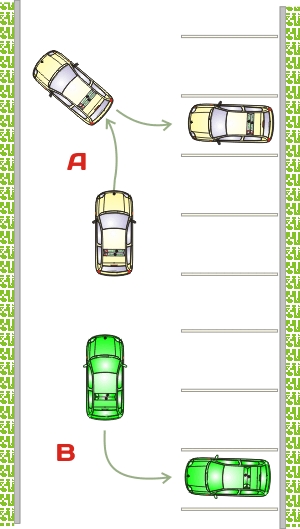
You can use these methods from either the left or right.
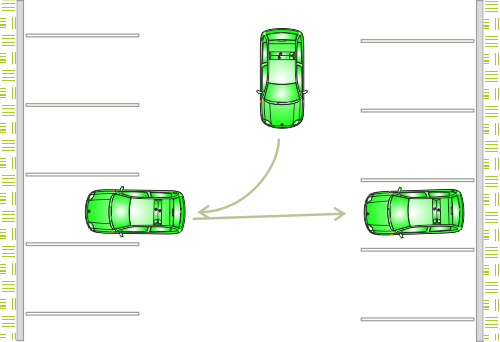
This is the easiest way to reverse into a bay, but take extreme care - others might not be expecting you to do this.
These methods are acceptable during your driving test, however, the limitations of space might dictate which method you choose. The driving test examiner might request that you reverse from a specific direction because of the car park layout. The method shown in the second diagram is unlikely to be available during a driving test..
While reversing into a bay is often the best and, with practise, the easiest way to park, there will sometimes be times when it makes sense to drive in.
The most common reason to drive in would be to load something into the back of your car, where there would not be enough space if you had reversed into the bay.
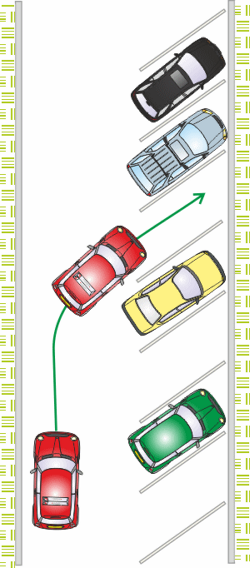 Some car parks are designed with a 'herringbone' layout, as shown in the diagram. These car parks maximise the available parking space.
Some car parks are designed with a 'herringbone' layout, as shown in the diagram. These car parks maximise the available parking space.
Driving into parking bays will mean that you have to reverse out.
Reversing out of a parking bay is included in the driving test because, although reversing in and driving out is the recommended and safest way to park, there will be times when driving in is necessary. For example, when you need to load something in the back (as mentioned above).
Reversing out of a bay will always be more hazardous than reversing in and driving out. You will need to cope with pedestrian and traffic activity but have a limited view. However, by following our advice, you should be able to reverse safely.
The safest way to reverse is to get a passenger to guide you. If you don't have a passenger, you must reverse very slowly.
By reversing very slowly, you give other car park users time to see you, and you will be able to stop quickly if the need arises. In a worst-case scenario, if you bump into something or someone you will do less damage if you are moving at a very slow walking speed.
Of course - with proper all-around observation, you should never bump into anything!
Whenever possible, you should look for a 'drive-through' space - where you can drive through an empty parking space straight into your bay. This way, you will get the benefits of driving out without having to reverse in.
Remember that car parks are used by pedestrians, including children, 'toddlers' and old people. Pedestrians can approach from any angle in a car park and might not be paying attention to the traffic – it's much easier to see them when you are driving out of a parking bay.
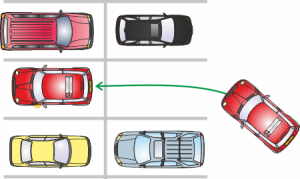 The benefits of reversing in or driving through so that you can drive out (as opposed to reversing out) include:
The benefits of reversing in or driving through so that you can drive out (as opposed to reversing out) include:
Efficiency: It takes a cold engine a couple of minutes to warm up and reach full efficiency; reversing out uses more fuel than driving out because it takes longer. Estimates say this could save as much as as £100 per year for some drivers!
Security: Personal and property security (see below)
Reversing in is easier than driving in: Space to manoeuvre is less restricted when reversing in.
Safety: Reversing out of a space can be hazardous in busy car parks and so is best avoided unless you need to drive in for some specific reason. Remember, driving out gives the driver a much clearer view of the vehicles, pedestrians, trolleys, toddlers and other hazards of busy car parks.
Before learning this manoeuvre, you should have fully mastered low-speed car control skills.
If you are driving a manual car and have problems with clutch-control, go back to basics before tackling this.
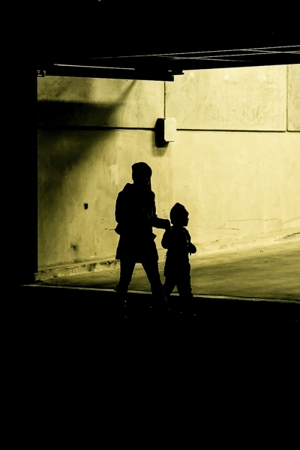 If you are driving an automatic or electric car, make sure you can move at a very slow walking pace (zimmer-frame speed), stopping and starting under complete control with no jerks or unexpected 'surges'.
If you are driving an automatic or electric car, make sure you can move at a very slow walking pace (zimmer-frame speed), stopping and starting under complete control with no jerks or unexpected 'surges'.
All-around observation is essential for any manoeuvre, but it becomes even more critical in car parks because there will often be a lot of pedestrian movement.
Other drivers who are manoeuvring their vehicles in or out of spaces, or looking for spaces, might not be paying as much attention as they should.
Small children are particularly vulnerable, especially in shopping centres/supermarket car parks. Their parents might be busy loading shopping and unaware of what their kids are doing - with this in mind, you must always be 100% certain that the space behind your car is clear before you start to reverse.
Although you will start your practise sessions in an empty car park, you must get into the habit of regular observation checks, keeping a careful lookout all around - all the time.
Door mirrors can be helpful for accurate positioning. You can adjust them to point downwards if necessary - however, there are two essential points to remember.
If you move your mirrors, remember to re-adjust them to the normal driving position as soon as you are parked.
When using mirrors for reversing, follow the same rules as when driving forwards - just quick glances to check your position. If you 'stare' at the mirror, you will tend to neglect other important areas.
If you use a reversing camera, follow the same advice as with mirrors - just quick glances to check your position. Never rely on a camera alone.
In some multi-storey or underground car parks you might need to use your headlights in order to see and be seen.
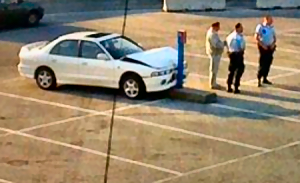
Different instructors suggest different methods for doing this manoeuvre. While learning a specific 'method' might be a useful starting point for some learners, trying to follow someone else's rules and reference points can be. Because of this, we do not recommend any specific method.
So what do we recommend?
Easy! Ask your driving supervisor to take you to an empty car park and play!
Get it 'wrong' a few times, experiment with the position and steering and focus on enjoying the process - you will probably learn quicker this way. But whatever you do, don't end up like the driver shown in the picture.
This car in the photo entered an empty railway station car park in Bern (Switzerland) at 7 am one morning, and the driver somehow managed to avoid the massive open space, driving their car into the only obstacle in sight, the parking meter! Don't ask how, we have no idea!

If you do the 'reverse into a parking bay' manoeuvre at the start of your test, the examiner will ask you to pull out of the bay at a 90-degree angle and straighten your wheels - the reason for this is to prevent drivers from pulling out and then reversing in on the same steering lock*.
*Steering 'lock' in this context refers to how far you turn the steering wheel.
After pulling out of the bay, straightening your wheels and stopping, you can reposition the car by either driving forwards or backwards to get into a good start position.
Examiners do not tell you that you can choose the start position for reversing. As explained above, they only ask you to pull out of the bay. If an examiner insists that a test candidate reverses from a fixed position or prevents them from repositioning, the test is not being conducted in accordance with the DVSA guidelines, and there may be grounds for an appeal.
The examiner will look for reasonable accuracy and good observation during your driving test.
You will not usually be penalised for crossing the lines when parking in an empty bay, as long as this is not excessive and you are reasonably accurate; however, you must park within the bay - parking across the lines is unacceptable. If necessary, pull forward and reverse to straighten the car well within the parking bay lines.
As we mentioned, even if you are reversing into an empty bay with no cars on either side and nobody around, you will still need to make your 'all around' observation checks. Failure to check will be recorded as a driving fault. Failure to see another car park user will likely result in a test fail.
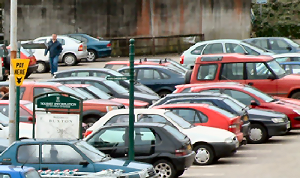
Sadly, car parks have become places where criminals have found some easy pickings.
However, there are many ways that you can take action to minimise the risk of becoming a 'car park victim' by using a little planning and 'security thinking'.
This information will help raise your awareness of potential parking 'trouble spots' so that you can avoid them altogether or take specific action to stay safe.
Your choice of parking space can make your vehicle unattractive to thieves or other criminals.
Use car parks with attendants where possible: Wherever possible, choose car parks with security patrols or CCTV cameras.
Park on the ground floor of multi-storey car parks: if this is not possible, park near the stairs or lift, well away from pillars and alcoves where people can hide. In open car parks, park as near to the pedestrian exit as possible; choose a space that is well away from shrubs and bushes.
At night choose well-lit car parks: Parking under a light whenever possible.
Reverse into car park spaces: This makes any valuables in the boot or rear of a hatchback harder to see and steal in large, multi-storey car parks where you can reverse up to a wall. Reversing in also makes it easier to 'get away' if you are threatened by a criminal (or perceive that you might be); you can drive forwards, even if someone managed to open one of the doors.
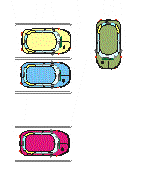
At night get someone to walk to your car with you if you are parked in a quiet car park (you can then give them a lift back). Ask the attendant to watch you on the security monitors in multi-storey car parks.
Unlocking: If you use a remote key fob, don't unlock your car until you are near it – unlocking too soon can alert unwanted attention or even allow a criminal to get into it. If you use a key, have it ready before reaching your car.
Before getting in, look through the rear windows to check behind the seats – when you are in, lock the doors immediately. If a stranger approaches, keep your windows closed - if you have any doubt about someone's intentions, start the engine and sound the horn (lots!).
You can find more driver security information in the DriverActive Drivers' Area.
 Car Parks Quiz...
Car Parks Quiz... Click here to complete the quiz for this lesson
(The page will open in a new window/tab)
You will find references for the answers in this lesson.
You can check your answers as you go along, or complete the full quiz before checking.
Leaving the check to the end is a good way to test yourself.
When you check or review your answers you will get a brief explanation of the answer.
Good Luck!